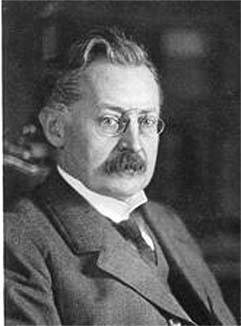Carl David Tolmé Runge
Carl David Runge Tolmé ( born August 30, 1856 in Bremen, † January 3, 1927 in Göttingen ) was a German mathematician.
Youth and Education
Runge was the son of the merchant Julius Runge and his wife Fanny Tolmé ( born in England ). His early years of childhood were spent in Havana, where his father managed the Danish consulate. In 1875 he graduated from the Gymnasium in Bremen. Then he accompanied his now widowed mother for half a year to Italy. He first studied literature and philosophy then mathematics at the University of Munich. In 1877 he continued his studies in Berlin, where he was particularly influenced by the mathematician Kronecker and Weierstrass. After 1880 his doctorate under Weierstrass and Kummer with the work over the curvature, torsion and geodesic curvature of curves drawn on a surface, he habilitated in 1883.
Professor in Hannover and Göttingen
In the spring of 1886 he became a full professor of mathematics at the Technical University of Hanover. In 1887 he married the daughter of the famous Berlin physiologist Emil Aimée Heinrich Du Bois -Reymond. With her he had four daughters and two sons, one of whom fell in the First World War. His son Wilhelm Runge also suggested an academic career.
In 1904 he was on efforts of Felix Klein to the newly created Chair of Applied Mathematics, the first of its kind in Germany, appointed at the Georg-August -Universität Göttingen.
Work as a mathematician
First, his field of work was characterized purely mathematical. From Kronecker he got the suggestion to number theory and Weierstrass theory of functions. In his time in Berlin he learned of his future father ( in whose family he much wrong ) of the Balmer series. In Hanover, he studied with Heinrich Kayser other line spectra and thus made contributions to the physics of spectroscopy. In Göttingen, he developed together with Martin Wilhelm Kutta Runge -Kutta methods for the numerical solution of initial value problems. His study of interpolation polynomials and their behavior when increasing the polynomial degree is known (see Runge's phenomenon). In the theory of functions he examined the approximability of holomorphic functions, arguing that Runge- theory.
The main scientific output of Runge was how Courant ( his son ) once aptly observed:
" The torn threads to the applications again make that will help restore the unity of mathematical science applications including "
International Contacts
Runge has taken several long trips. His language skills, especially in English, came to him in good stead. In 1897 he attended the meeting of the British Association in Toronto and subsequently all major American observatories. Along with Karl Schwarzschild in 1906, he undertook an eclipse expedition to Algiers. In the winter of 1909 he spent a year as an exchange professor at the Columbia University in New York. This is followed by closing a second tour of America, where he attended alongside universities and observatories, the places of his childhood in Havana. In the summer of 1926 he attended the meeting of the British Association at Oxford.
The personality
Runge is portrayed as a very amiable and modest man. He loved the house music, which he himself played the piano. He loved sports such as tennis, ice skating and skiing, gymnastics, hiking, swimming, boating and cycling. In Hanover, he drove regularly between his home in the village Kirchrode and is 10 km from university by bicycle. His bicycle he almost never cleaned and used to say: "It finally provides a dynamic equilibrium: as much dirt as every day injects it, also falls daily from self again ." In Göttingen, he lived with his family in the Wilhelm -Weber -Straße 21, not far from Felix Klein.
Miscellaneous
In 1914 he was president of the German Mathematical Society.
His daughter Nerina (Nina ) was married to Richard Courant. His daughter Iris Runge was one of the first industrial mathematicians ( she worked at Osram and Telefunken ). His son William Tolmé Runge was in the high-frequency technology at Telefunken.
The lunar crater Runge was named after him in 1973.







